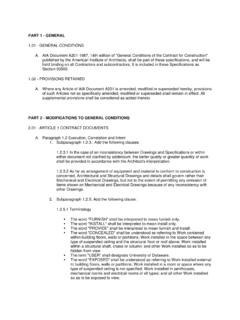Transcription of THIRTY YEARS OF RESEARCH ON RACE DIFFERENCES IN …
1 THIRTY YEARS OF RESEARCH ON RACEDIFFERENCES IN COGNITIVE ABILITYJ. Philippe RushtonThe University of Western OntarioArthur R. JensenUniversity of California, BerkeleyTheculture-only(0% genetic 100% environmental) and thehereditarian(50%genetic 50% environmental) models of the causes of mean Black White differencesin cognitive ability are compared and contrasted across 10 categories of evidence:the worldwide distribution of test scores,gfactor of mental ability, heritability, brainsize and cognitive ability, transracial adoption, racial admixture, regression, relatedlife-history traits, human origins RESEARCH , and hypothesized environmental vari-ables.
2 The new evidence reviewed here points to some genetic component inBlack White DIFFERENCES in mean IQ. The implication for public policy is that thediscrimination model ( , Black White DIFFERENCES in socially valued outcomeswill be equal barring discrimination) must be tempered by a distributional model( , Black White outcomes reflect underlying group characteristics).Section 1: BackgroundThroughout the history of psychology, no question has been so persistent orso resistant to resolution as that of the relative roles of nature and nurture incausing individual and group DIFFERENCES in cognitive ability (Degler, 1991;Loehlin, Lindzey, & Spuhler, 1975).
3 The scientific debate goes back to themid-19th century ( , Galton, 1869; Nott & Glidden, 1854). Starting with thewidespread use of standardized mental tests in World War I, average ethnic andracial group DIFFERENCES were found. Especially vexing has been the cause(s) ofthe 15-point Black White IQ difference in the United 1969, theHarvard Educational Reviewpublished Arthur Jensen s lengthyarticle, How Much Can We Boost IQ and School Achievement? Jensen con-cluded that (a) IQ tests measure socially relevant general ability; (b) individualdifferences in IQ have a high heritability, at least for the White populations of theUnited States and Europe; (c) compensatory educational programs have provedgenerally ineffective in raising the IQs or school achievement of individuals orgroups; (d) because social mobility is linked to ability, social class DIFFERENCES inIQ probably have an appreciable genetic component.
4 And tentatively, but mostcontroversially, (e) the mean Black White group difference in IQ probably hassome genetic s (1969) article was covered inTime,Newsweek,Life, News &World Report, andNew York Times Magazine. His conclusions, the theoreticalissues they raised, and the public policy recommendations that many saw asstemming directly from them were dubbed Jensenism, a term which entered theJ. Philippe Rushton, Department of Psychology, The University of Western Ontario, London,Ontario, Canada; Arthur R. Jensen, School of Education, University of California, concerning this article should be addressed to J. Philippe Rushton, Departmentof Psychology, The University of Western Ontario, London, Ontario N6A 5C2, Canada.
5 Public Policy, and Law2005, Vol. 11, No. 2, 235 294 Copyright 2005 by the American Psychological Association1076-8971/05/$ DOI: Since 1969, Jensen has continued to publish prolifically on all of theseissues, and increasing numbers of psychometricians and behavioral geneticistshave come to agree with one or more of the tenets of Jensenism (Snyderman &Rothman, 1987, 1988).The Bell Curve(Herrnstein & Murray, 1994) presented general readers anupdate of the evidence for the hereditarian position along with several policyrecommendations and an original analysis of 11,878 youths (including 3,022 Blacks) from the 12- year National Longitudinal Survey of Youth.
6 It found thatmost 17- year -olds with high scores on the Armed Forces Qualification Test,regardless of ethnic background, went on to occupational success by their late 20sand early 30s, whereas those with low scores were more inclined to welfaredependency. The study also found that the average IQ for African Americans waslower than those for Latino, White, Asian, and Jewish Americans (85, 89, 103,106, and 113, respectively; Herrnstein & Murray, 1994, pp. 273 278).Currently, the standard deviation difference in average IQ between Blacksand Whites in the United States is not in itself a matter of empirical dispute. Ameta-analytic review by Roth, Bevier, Bobko, Switzer, and Tyler (2001) showedit also holds for college and university application tests such as the ScholasticAptitude Test (SAT;N million) and the Graduate Record Examination(GRE;N million), as well as for tests for job applicants in corporate settings(N million) and in the military (N million).
7 Because test scores arethe best predictor of economic success in Western society (Schmidt & Hunter,1998), these group DIFFERENCES have important societal outcomes (R. A. Gordon,1997; Gottfredson, 1997).The question that still remains is whether the cause of group DIFFERENCES inaverage IQ is purely social, economic, and cultural or whether genetic factors arealso involved. Following publication ofThe Bell Curve,the American Psycho-logical Association (APA) established an 11-person Task Force (Neisser et al.,1996) to evaluate the book s conclusions. Based on their review of twin and otherkinship studies, the Task Force for the most part agreed with Jensen s (1969)Harvard Educational Reviewarticle andThe Bell Curve,that within the Whitepopulation the heritability of IQ is around.
8 75 (p. 85). As to the cause of themean Black White group difference, however, the Task Force concluded: Thereis certainly no support for a genetic interpretation (p. 97).Among the factors contributing to the longstanding lack of resolution of thisimportant and controversial issue are the difficulty of the subject matter, thepolitical issues associated with it and the emotions they arouse, and the differentmeta-theoretical perspectives of the experimental and correlational methodolo-gies. Cronbach (1957) referred to these conflicting approaches as the two halves of psychology because researchers are predisposed to draw different conclusionsdepending on whether they adopt a manipulations-lead-to-change or a corre-lations-find-stability we review in detail the RESEARCH that has accumulated since Jensen s(1969) article and compare our findings with earlier reviews and evaluations suchas those by Loehlin et al.
9 (1975), P. E. Vernon (1979), Herrnstein and Murray(1994), the APA Task Force (Neisser et al., 1996), and Nisbett (1998). Facts inthemselves typically do not answer scientific questions. For a question so complexas the cause of the average Black White group difference in IQ, no one fact, one236 RUSHTON AND JENSEN study, nor indeed any single line of evidence, can hope to be , resolving the issue requires examining several independent lines ofevidence to determine if, when taken together, they confirm or refute rivalhypotheses and RESEARCH philosophy of science methodology used here is guided by the view that,just as in individual studies the principal of aggregation holdsthat a set ofmeasurements provides a more reliable indicator than any single measure takenfrom the set(Rushton.)
10 Brainerd, & Pressley, 1983), so in reviewing multiple linesof evidence, making strong inferences from a number of contending hypothesesis more efficacious than considering only one hypothesis at a time (Platt, 1964).Although strong inference isthemethod of science, it has, more often than not,been eschewed in this controversial final section of this article addresses the question of what these conclu-sions imply for policy, specifically for the issues of educational and psychologicaltesting, health, race relations, and conflicting worldviews about the essence ofhuman nature. It suggests that the distributional model that takes genetic factorsinto account must temper the discrimination model that explains Black Whitedifferences in socially valued 2: The Two Conflicting RESEARCH ProgramsHere, we review the RESEARCH on Black White difference in average IQpublished since Jensen s (1969) now 36- year -old article.










